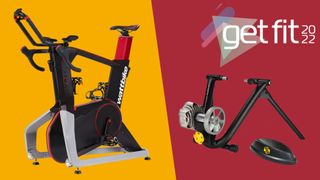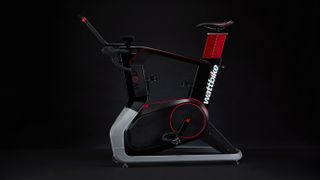Turbo trainer vs smart bike – which is right for you?
Indoor cycling is booming. But are you better using your own bike and a turbo trainer or a standalone smart bike?

Cycling on a stationary turbo trainer or smart bike is a phenomenal workout and the perfect addition to pursuing almost any sport or fitness goal. From office workers spinning at the gym, through burly rugby players chasing cardio gains, to bike racers honing their finishing sprint, ever more people are discovering that indoor cycling is a time-efficient way to get a high-intensity, low-impact workout.
Not just a replacement for getting outside, indoor cycling actually has several distinct training benefits over hitting the open road. First, it’s more efficient, as unlike dodging in and out of traffic, an hour on a turbo or smart bike always provides a complete hour of structured training.
Second, it’s safer and easier to achieve some types of workout indoors, such as the sort of repeated high-intensity efforts that would normally leave you swerving all over the tarmac.
Third, thanks to both virtual classes and the gamification of training, it’s easy to stay motivated, especially when the weather outside is grim.
Now sporting wireless connectivity and smart resistance, the latest static bikes and trainers can also log you into apps like Zwift where it’s possible to ride virtual courses and compete against riders around the world. Similarly, there are a host of platforms that will let you join a group and work through a spin class from home.
Of course, to give any of this a go you’re either going to need your bike and a matching turbo trainer or one of the latest generation of smart indoor bikes. But what are the benefits of each style?
Already know what you'd prefer? We've collected the best deals on a range of top turbo trainers and stationary bikes right here. Otherwise, read on...
Get daily insight, inspiration and deals in your inbox
Get the hottest deals available in your inbox plus news, reviews, opinion, analysis and more from the TechRadar team.
Turbo trainers
A turbo trainer consists of a resistance unit that creates the sensation of riding by giving your legs something to push against. Coming in wheel-on or direct-mount styles, you take your regular bike, and either drop the rear wheel onto the turbo’s drum or remove it and bolt the bike directly onto the device.
Controlled by smart circuitry, and generating their resistance through electromagnetism, the latest smart trainers can simulate the feeling of riding up gradients of over 20% along with the sensation of freewheeling back down. Set up in front of a smart TV or tablet and connected to an online platform like Zwift, this can give you the impression of riding in a virtual world, with the effort required by your legs matching in real-time what’s happening on the screen.
Slightly less fun, but even more useful for training, they can also guide you through set workouts, varying your level of suffering to match each interval in the program.

Using your own bike, one benefit of a conventional turbo trainer is that you’ll instantly feel at home. The flip side of this is that your drivetrain and tires will wear as you pedal, while bikes can also be surprisingly sensitive when sweated over.
Previously somewhat noisy, the latest turbos are now quiet enough to go unnoticed by your neighbors. However, the state of your bike can affect the level of noise they generate, and a badly maintained bike can be surprisingly creaky.
There’s also the fact that you’ll need to set everything up each time you use it. Only the work of a minute or two it’s nevertheless the type of minor hassle that can sap your resolve when it comes to ducking out of a planned session.
Yet while it’s nice to always have a bike set-up and ready to go, not all of us have limitless space. In this respect, turbo trainers score highly for portability and storage. With most folding down to a size that’ll slide under a bed, dedicated bike racers will also appreciate the ability to transport them to events for a pro-style warm-up.
The cheapest introduction to indoor cycling, basic turbos with rudimentary connectivity such as the Saris Fluid2 Smart start at $350 / £250 / AU$400, while a top-end trainer can cost twice as much.
Look out for big names like Tacx, Wahoo, or Elite, all of which create products that do an excellent job of bringing the feel of the open road into your living room or garage. For those wanting to track their progress, models with in-built power sensors will also give you direct insight into your changing performance.
Smart bikes
The boom in spinning and indoor cycling has seen everyone from celebrities to pro football teams adding indoor riding to their workout routines. There are lots of static bikes available, from simple models that use magnetic resistance through to sophisticated spin bikes from the likes of Peloton, but if you’re looking for a truly dynamic experience then you’ll need a smart bike.
All indoor bikes have the benefit of being always ready to go after the initial setup, making them much less hassle to use daily than a turbo trainer. They’re surprisingly quiet, and wear is almost a non-issue. What sets smart bikes apart, however, is their ability to change the resistance level automatically and in real time based on data from a connected app, giving you a more realistic riding experience that adapts on the fly to suit your needs.
Smart bikes from brands including Wattbike, Stages and Wahoo range from $2,600 / £2,000 / AU$3,500 for an entry-level model, up to $4,000 / £3,200 / AU$5,000 for the latest top-end version. These bikes feature instant resistance adjustment, simulated gearing, power measurement, and (in the case of the Wattbike Atom) pedaling efficiency analysis. Basically, everything you’d expect from a high-end turbo – and then some.

Providing enough training insight to make them a hit with pro athletes, those a few rungs down the athletic career ladder will appreciate the ability to easily run through complex workouts or combine exercise with play on virtual racing apps like Zwift.
Spin bikes might look similar to smart bikes, but have quite different features. For a start, most don’t have the same level of smart integration, instead requiring the user to dial in the level of resistance they require. Often using a fixed gear and a large, heavy flywheel, this combination means you have to pedal continuously, a trait that can feel odd at first but helps create flexibility and strength in the legs. However, they don’t provide the same dynamic changes in resistance as a smart bike.
Smart bikes are ideally suited to those who want to bring the gym experience home with them. At the same time, anyone that wants to keep their regular bike for cycling outdoors, or who doesn’t have a bike to start with, will also be well-served – assuming they’ve got the funds and space required to accommodate their larger size and cost.
This article is part of TechRadar's Get Fit in 2022 series – a collection of ideas and guides to help get your new year's health goals off to the right start, whatever your current level of fitness.

Former magazine editor and freelance writer Joseph Delves has written for publications including Lonely Planet, Cyclist, Rouleur, and FACT mag. A fan of various outdoor pursuits from hiking and climbing to swimming and cycling, he’s produced several hundred well-received reviews and a few somewhat less popular short stories. With a lax attitude to both training and reading instruction manuals, he’s a firm believer that technology should always make life easier and ideally more fun too.
Most Popular

